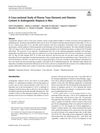Distribution of Copper, Manganese, Selenium, and Zinc in Occipital and Frontal Hair Zones and Hormonal Profiles in Women with Androgenetic Alopecia
July 2013
in “
Surgery
”

TLDR Women with a certain type of hair loss have more copper in the back of their head than the front, and treatment can normalize hair but not copper levels.
The study, conducted 10 years ago, involved 153 women aged 18-45 with androgenetic alopecia (AGA), a type of hair loss. The research found that 33.3% and 24% of the AGA group had excess levels of dihydrotestosterone (DHT) and androstenedione (A) respectively, compared to 18% and 15% in the control group. The level of copper (Cu) in the occipital area (back of the head) was higher than in the frontal zone (front of the head) in women with AGA, with 30.7% having copper hair levels above the cutoff of 17 mg/kg, compared to 12% in the control group. Decreased levels of manganese (Mn) and zinc (Zn) were associated with excess A and DHT. After treatment with a local inhibitor of 5 alpha-reductase, a key enzyme in the production of DHT, the main morphological parameters of the hair returned to normal range. However, the copper content did not change before and after treatment. The researchers hypothesized that the difference in copper levels in the frontal and occipital areas reflected the ratio of 5 alpha-reductase activity to aromatase, an enzyme that converts androgens to estrogens. This might explain why using only a 5 alpha-reductase inhibitor was ineffective in women in practice.
